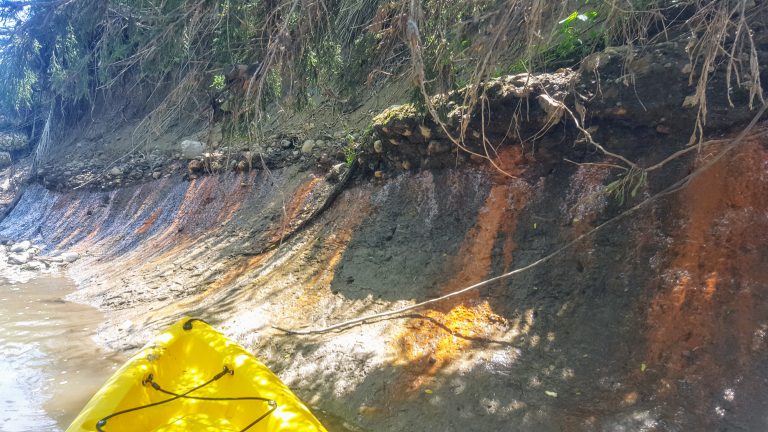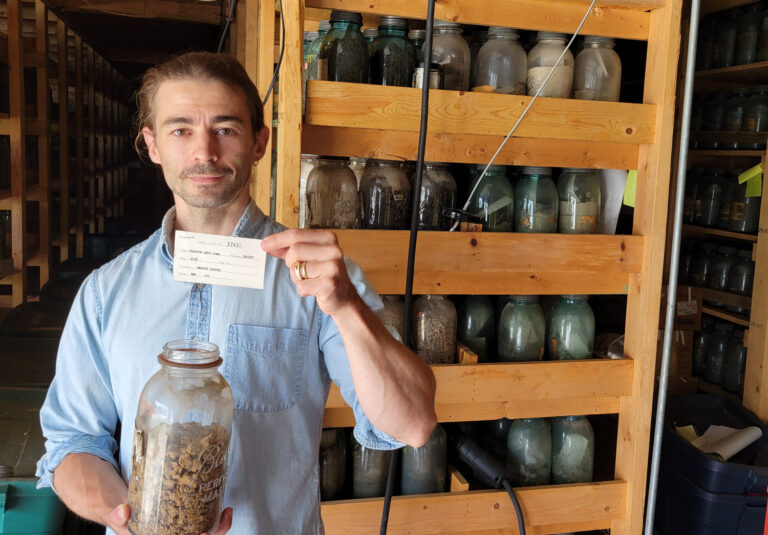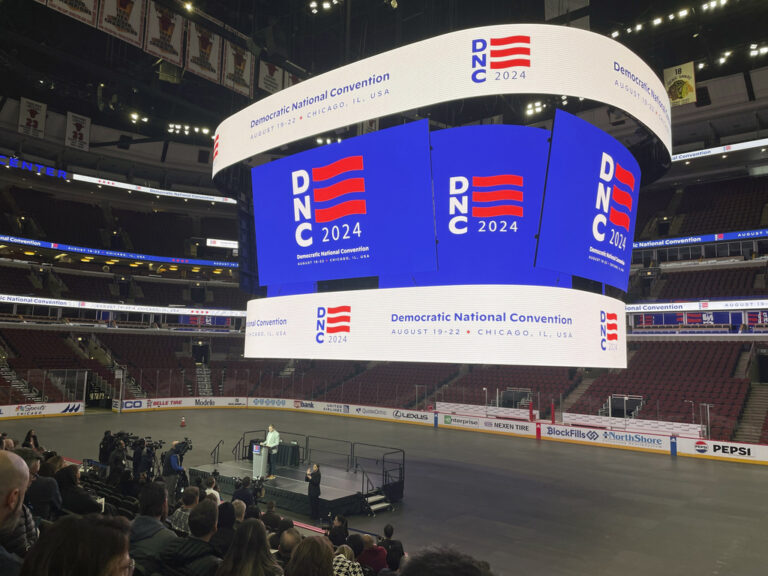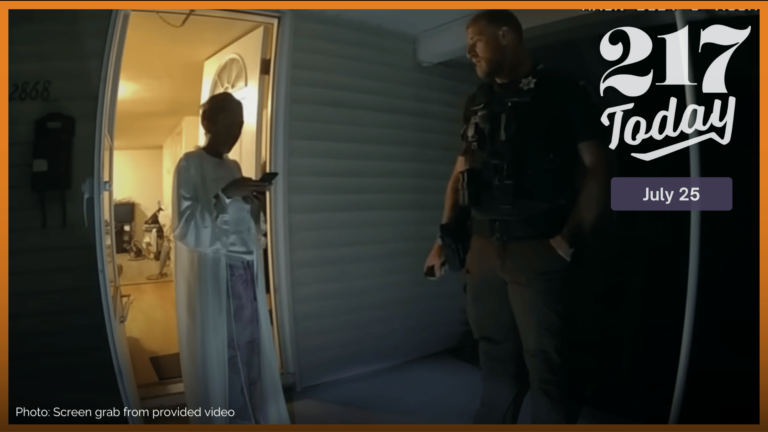OAKWOOD — Illinois Attorney General Kwame Raoul and Vermilion County State’s Attorney Jacqueline Lacy announced on Tuesday they were suing Dynegy Midwest Generation over the disposal of coal ash at the shuttered Vermilion Power Station. That coal ash has been in retention ponds near the Middle Fork of the Vermilion River.
Later that day, Raoul and Lacy announced they filed a motion to enter an agreed interim order with Dynegy. That order requires the company to develop a safety emergency response plan for the site, among other things.
Illinois Newsroom’s Brian Moline spoke with Andrew Rehn about these developments. He’s the Water Resources Engineer for Prairie Rivers Network in Champaign, one of the groups that’s been working to force Dynegy to clean up this site.
This interview has been lightly edited for clarity.
Brian Moline: Andrew, a couple of news items on this came out just yesterday (Tuesday). First, the announcement that there was a lawsuit filed by Illinois Attorney General Kwame Raoul and Vermilion County State’s Attorney Jacqueline Lacy. That linked the disposal of coal ash in those on-site ponds with contamination of surrounding groundwater and the Middle Fork of the Vermilion River. And then later in the day, there was an announcement that those two parties have also filed a motion to enter an agreed interim order that requires Dynegy to, in part, create a safety emergency response plan for the site. So, taking those two items together. Andrew, where would you say things stand right now with the coal ash ponds and and Dynegy?
Andrew Rehn: A big part of that interim order is also that Dynegy is required to propose a closure plan that removes the coal ash and present that plan to the public by December 17, essentially putting them on a course to follow our new coal ash rules for the process of closing the ponds, removing the ash. And that’s the biggest win here. That’s the thing to really see is that Dynegy is saying, ‘Alright, we’ll move the ash.’ And this is the first time we’ve gotten them anywhere close to saying that.
So in that way, it is a really big win. It is an important step. We’re getting pointed in the right direction. We’re making big progress. And it’s going to be about making sure that the steps along the way get followed in the right way. And we keep moving the ship in that direction. So part of that interim order included the safety plan, included monitoring the riverbank, preparing a plan for temporary stabilization if they needed to deploy that. Preparing a groundwater trench to start capturing leachate that might be going into the river that is growing in the river. And starting to de-water the ash, which is where you pull water out of the ash so that it’s dry so that you can start working it to move in and out.
BM: And could you just remind us why you and so many other folks who’ve been working on this feel it’s so important to actually move that coal ash? Why is that such an important aspect of this?
AR: So, there’s two problems at the site. The first is that it’s continually seeping pollution into the Middle Fork, and this you can see the the stained riverbank, the oily layer on that same riverbank, and it constantly seeping into the river.
The other aspect is that the river is a naturally meandering river that erodes over long periods of time from one side to the other side of its floodplain. Its floodplain is its domain, and it is rapidly eroding towards those ash ponds. And if it undercuts, then they’ll get dumped into the river. And we’ll have coal ash all the way down to Danville if we leave it or even if we put in some armoring.
We’d like to see this river protected for generations, to come not some solution that’s going to have to be revisited later. And that river is going to meander back and forth between the bluffs on either side. So it will cut away at the ash is left there, it’s eventually going to be put into the river. So we really want to see a solution that that gets it out of there once and for all, so that we know it’s going to be safe.
BM: And then again, specifically about the coal ash, what are the the things in that coal ash that are that are so bad for groundwater and the environment and why?
AR: Coal ash contains heavy metals, things like arsenic, boron, chromium, lead, some ash contains things like Selenium, vanadium. It can contain a whole bunch of different stuff, depending on where it was burned, where it came from, the technology that it was burned with. And these pollutants are concentrated in the coal ash. So they naturally occur in coal.
But when you burn it, what’s left over has those pollutants at higher concentrations. And then it’s stored in these large impoundments for decades, where it’s exposed to water, and then those pollutants leach into the groundwater. And then that groundwater migrates towards places like the Middle Fork or off the property of the site. So we have pollutants coming into the Middle Fork at levels above, you know, what the US EPA and the Illinois EPA have decided are safe thresholds. And we have groundwater polluted at above the what Illinois EPA has has decided are safe thresholds. So you know, it’s really about protecting the clean water and making sure that those pollutants aren’t impacting the river or the wildlife or people.
BM: So going forward, what will Prairie Rivers Network and other environmental groups be looking for from — I guess, Vistra is the company at this point who who bought Dynegy — but what will you be looking for from Vistra to make sure they follow through on what’s been agreed to?
AR: Each of these proposed safety measures is going to require different regulatory processes. So to install a groundwater trench means you’re pumping groundwater, meaning that you’re going to put it somewhere and so they’re likely going to have to work with Illinois EPA to figure out where that goes, and that will need a permit.
We’re going to work with folks like Ecojustice Collaborative and Earthjustice and the public to make sure that that permit looks good, that that water is being managed properly, it’s not going the wrong place. Same goes for any temporary bank stabilization, that’s likely going to require the Army Corps (of Engineers). And that’s going to be a permanent process as well. And then ultimately, the closure plan is a permanent process that goes through the Illinois EPA. So we’re going to be here all along the way, keeping an eye on what they’re proposing, how it’s going to impact the river, if it is truly the safest, most protective thing that they can do. And making sure that it’s all done right.
BM: And before I let you go, Andrew, I just wanted to try and get a little clarity in my own mind as to I guess, where things are because first we had the lawsuit then we had this agreement. Does the agreement affect the lawsuit in any way? Is the lawsuit still happening? How does all that work together in this whole process?
AR: Well, I have to lead with, I’m not a lawyer. My understanding is that the agreed-to interim order is essentially, ‘hey, let’s agree to this and follow this. And, we’re good as long as we feel like you’re you’re honestly going with this agreement,’ but the lawsuit’s still there, it doesn’t go away.
So the state of Illinois is still holding on to that lawsuit as a tool to make sure that if Dynegy doesn’t go along with with what they said they would go along with, they have that as a backup. And I should add, that Prairie Rivers Network, represented by Earthjustice, still has our lawsuits at the site. And those are going to be other backstops to make sure that the outcomes at the middle for the Middle Fork and at the Vermillion site are ones that are protective and helping restore the river. And those aren’t really playing into this agreement. That’s an agreement between the state and Dynegy, but they give us additional safeguards.
Dynegy’s parent company, Vistra, emailed us the following statement about the lawsuit and interim order:
Since taking ownership of the former Vermilion plant site from Dynegy in 2018, the company has been clear in its belief that work is needed — work that has stalled for too long without resolution or action. That is why we are pleased to have reached a tentative settlement, pending court approval, with the State of Illinois to move forward with environmental protections at the Vermilion plant site.
In accordance with state permits, coal ash was lawfully managed in man-made impoundments located adjacent to the Middle Fork of the Vermilion River. The proximity of the ash ponds to the river has led to concerns that contaminants were migrating from the impoundments to groundwater and ultimately to the river. As such, since acquiring the plant in 2018, we have been working diligently with the Illinois Environmental Protection Agency to come up with an acceptable solution.
While we believe certain closure alternatives without removal of all the ash would be protective, given the unique nature of the site and to resolve the pending dispute with the State of Illinois, we have agreed to close all of the impoundments by removal. Also, given the proximity of the impoundments to Illinois’ only National Scenic River, the meandering nature of the river, and the recreational uses of the river, we have agreed to take the enhanced measures outlined in the proposed Interim Order.
We believe this is an important step in addressing the public’s long-standing concerns. These measures will address the potential impacts on area groundwater and the Middle Fork and provide for meaningful public participation as we move forward to closing the impoundments.







